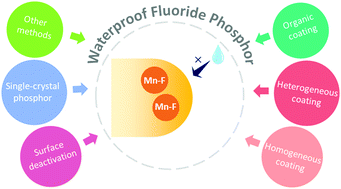Towards improved waterproofness of Mn4+-activated fluoride phosphors
Abstract
The Mn4+-activated fluoride phosphor, typically K2SiF6:Mn4+, has become a renowned red-emitting phosphor for white light emitting diodes (LEDs) due to its sharp line-type luminescence spectrum peaking at ∼630 nm. However, fluoride phosphors exhibit a relatively poor water resistance as [MnF6]2− groups are prone to hydrolysis under humid conditions, which leads to the formation of Mn-(hydro)oxides causing a severe decrease of the luminescence efficiency. This review summarizes six strategies that have been employed to improve the waterproofness of Mn4+-doped fluoride phosphors, including organic coating, inorganic heterogeneous/homogeneous coatings, surface deactivation (reduction of surface Mn4+), preparation of single crystal phosphors, and other methods (solid solution, Nb5+ oxidation, structural rigidity-enhancement, etc.). The pros and cons of each strategy have been compared, and, finally, several perspectives, such as the development of single crystal phosphors with low solubility to achieve better waterproofness, have been proposed.

- This article is part of the themed collection: Recent Review Articles


 Please wait while we load your content...
Please wait while we load your content...